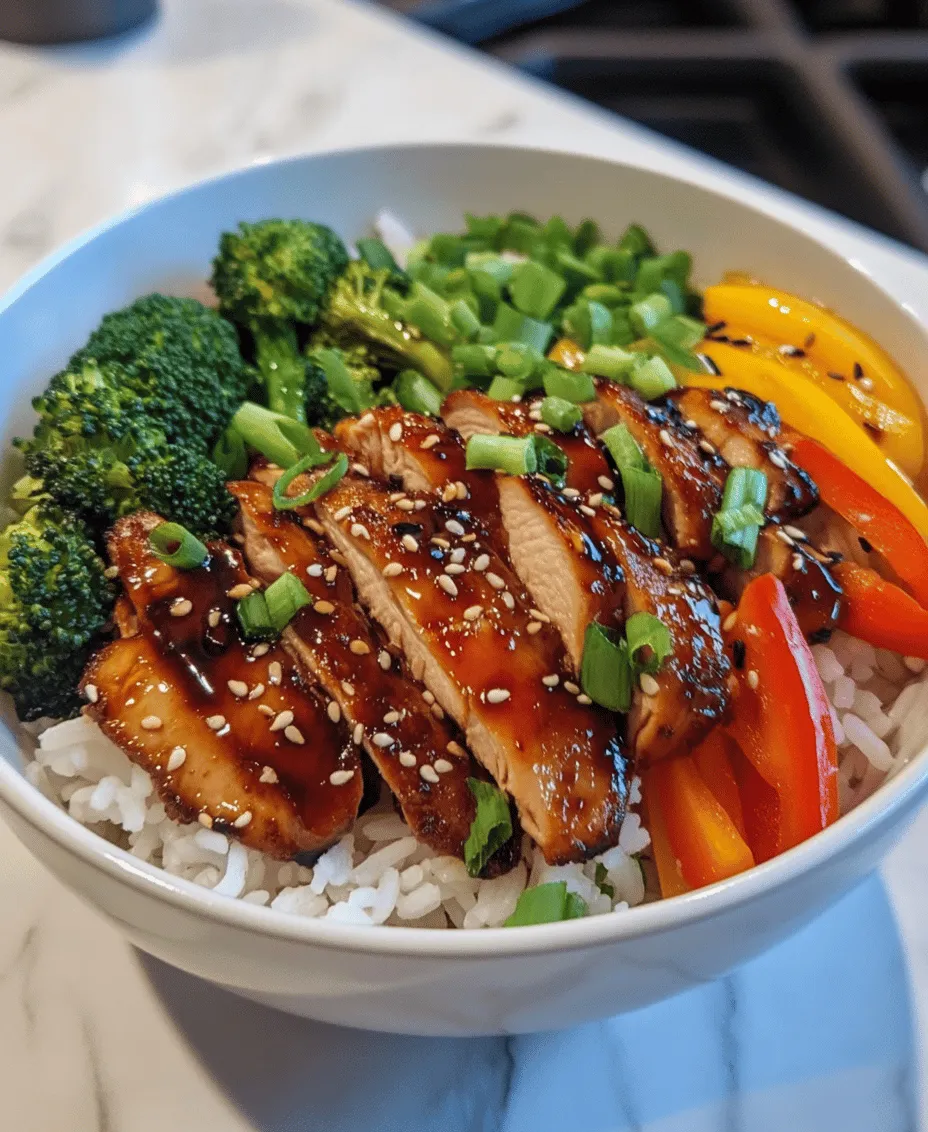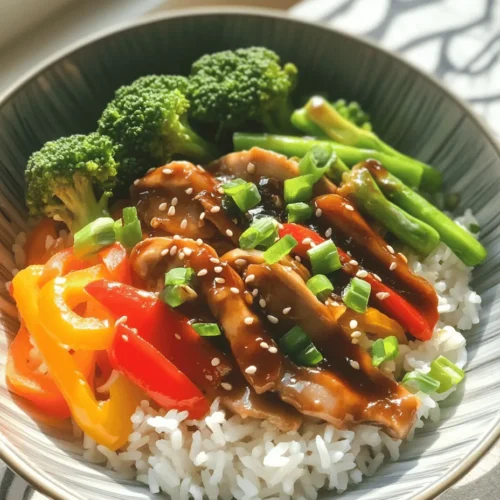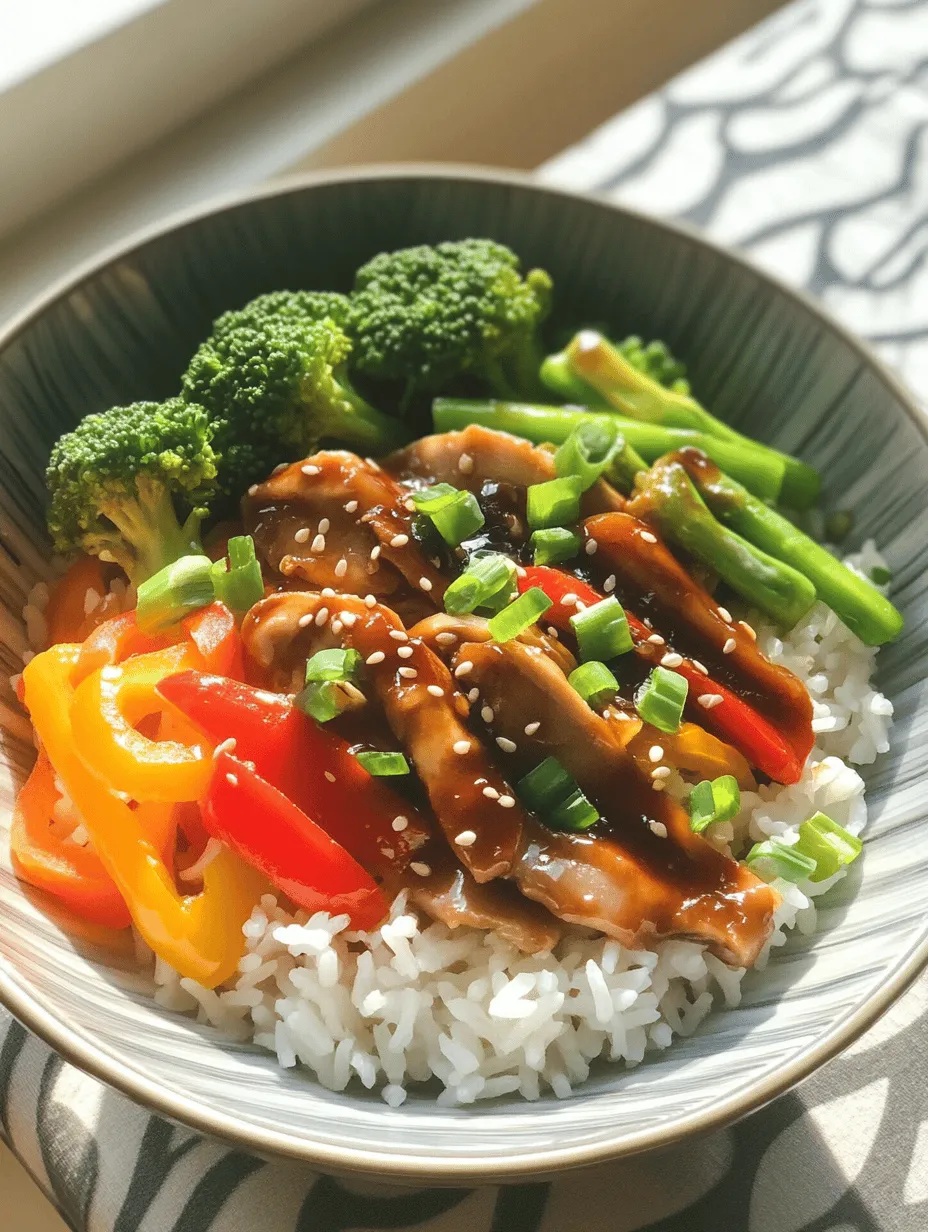The Teriyaki Chicken Rice Bowl is a delightful fusion of flavors that brings together succulent chicken, aromatic jasmine rice, and vibrant vegetables. This dish not only satisfies the palate but also provides a balanced meal that is both nutritious and easy to prepare. The sweet and savory teriyaki sauce, combined with tender chicken and fresh veggies, makes this bowl a household favorite. In this article, we will walk you through the ingredients, preparation steps, and tips for creating the perfect Teriyaki Chicken Rice Bowl. Whether you are a novice in the kitchen or an experienced chef, this recipe will guide you to a delicious result that can be enjoyed at any time.
Understanding Teriyaki: A Flavorful Japanese Tradition
Exploring the Origins of Teriyaki
Teriyaki, a culinary term that translates to “glazed grill,” has its roots deeply embedded in Japanese cuisine. The cooking technique dates back to the Edo period (1603-1868) when it was popularized among Japanese households and restaurants. Traditionally, teriyaki involves grilling or broiling meat—often fish or chicken—coated with a glossy marinade made from soy sauce, sake, and sugar.
Over time, teriyaki has evolved from its humble beginnings into a beloved dish not just in Japan but around the world. The marinade’s sweet and savory flavors have captured the hearts and taste buds of many, leading to its adaptation in various forms and ingredients. Today, teriyaki is celebrated for its versatility, allowing cooks to experiment with different proteins, making it a common feature in bento boxes and casual dining.
The Role of Teriyaki in Japanese Cuisine
In Japanese cuisine, teriyaki is not merely a cooking style; it represents a harmonious blend of flavors that enhance the natural taste of the ingredients. The emphasis is on balance—between sweet, salty, and umami. The teriyaki sauce has become so integral to Japanese cooking that it is often used as a marinade for grilled meats and vegetables, lending a distinct flavor that is both comforting and satisfying.
The popularity of teriyaki has also spurred a global appetite for Japanese-inspired dishes, leading to its presence in various international menus. The Teriyaki Chicken Rice Bowl, in particular, exemplifies how traditional Japanese flavors can be incorporated into modern, easy-to-make meals that cater to diverse tastes and dietary preferences.
The Key Ingredients of Teriyaki Sauce
To create an authentic teriyaki flavor, it’s essential to understand the key components of the sauce that gives the dish its signature taste.
– Soy Sauce: The Umami Backbone
Soy sauce is the cornerstone of teriyaki sauce, providing that rich umami flavor that defines many Asian dishes. It is typically made from fermented soybeans, giving it a savory taste that pairs perfectly with chicken. For a healthier option, opting for low-sodium soy sauce is recommended to control the saltiness while still enjoying the full flavor.
– Sweeteners: Honey vs. Brown Sugar
Sweetness is a critical element in teriyaki sauce, balancing the saltiness of the soy sauce. While traditional recipes may use white sugar, many modern cooks prefer natural sweeteners like honey or brown sugar. Honey adds a floral note that enhances the overall flavor, while brown sugar contributes a deeper, caramel-like sweetness, making both options delightful choices.
– Other Essential Elements: Rice Vinegar and Sesame Oil
To elevate the teriyaki sauce, rice vinegar is often added for a touch of acidity, which helps brighten the flavors. Sesame oil, with its nutty aroma, can also be included for depth and richness. These components work together to create a well-rounded sauce that clings beautifully to the chicken in the Teriyaki Chicken Rice Bowl.
Ingredients Breakdown for the Teriyaki Chicken Rice Bowl
To make a delicious Teriyaki Chicken Rice Bowl, it’s crucial to select fresh and high-quality ingredients. Here’s a breakdown of what you’ll need:
– Fresh and High-Quality Chicken Thighs
Chicken thighs are the preferred choice for this recipe due to their tenderness and flavor. Unlike chicken breasts, thighs retain moisture during cooking, resulting in juicy bites that soak up the teriyaki sauce perfectly. When selecting chicken, look for organic or free-range options for the best taste and quality.
– Jasmine Rice: Why It’s the Best Choice
Jasmine rice is the ideal grain for this dish, known for its fragrant aroma and slightly sticky texture. This long-grain rice pairs well with the teriyaki sauce, allowing it to absorb flavors without overpowering the dish. Its light, fluffy texture complements the tender chicken and fresh vegetables beautifully.
– The Importance of Low-Sodium Soy Sauce
As mentioned earlier, using low-sodium soy sauce helps control the overall saltiness of the dish while still delivering that rich umami flavor. This choice is particularly beneficial for those monitoring their sodium intake, ensuring that the meal remains healthy without sacrificing taste.
– Selection of Vegetables for Color and Nutrition
A colorful array of vegetables not only enhances the visual appeal of your Teriyaki Chicken Rice Bowl but also adds nutritional value. Common choices include bell peppers, broccoli, snap peas, and carrots. These vegetables provide crunch, vibrant colors, and essential vitamins, creating a well-rounded meal.
Preparation Steps for the Perfect Teriyaki Chicken Rice Bowl
Now that you have gathered all the essential ingredients, let’s delve into the preparation steps that will lead you to a mouthwatering Teriyaki Chicken Rice Bowl.
Marinating the Chicken for Maximum Flavor
One of the critical steps in achieving a rich flavor in your Teriyaki Chicken Rice Bowl is marinating the chicken. The process of marinating not only enhances the taste but also tenderizes the meat, making it juicier when cooked.
– The Science Behind Marinating
Marinating involves soaking the chicken in a mixture of teriyaki sauce and other flavor enhancers for a specified period. The acids in the marinade, such as rice vinegar, help break down the protein fibers in the chicken, resulting in a more tender texture. At the same time, the flavors from the marinade infuse into the meat, ensuring every bite is bursting with flavor.
– Recommended Marinating Times
For optimal results, marinate your chicken thighs for at least 30 minutes, but ideally for 2 to 4 hours. If time permits, marinating overnight in the refrigerator will yield the best flavor. Avoid marinating for more than 24 hours, as the chicken may become overly tender and mushy.
Cooking the Jasmine Rice to Perfection
While the chicken is marinating, it’s essential to prepare the jasmine rice correctly to ensure it complements the dish beautifully.
– The Rinsing Process: Why It Matters
Rinsing jasmine rice before cooking removes excess starch that can make the rice gummy. To achieve fluffy rice, place the rice in a fine-mesh strainer and rinse under cold running water until the water runs clear. This step helps improve the texture, ensuring that the grains remain separate and light.
– Tips for Achieving Fluffy Rice
After rinsing, cook the jasmine rice using the absorption method for the best results. Combine one cup of rinsed jasmine rice with one and a half cups of water in a saucepan. Bring to a boil, then reduce the heat to low, cover, and simmer for 15 minutes. Once cooked, remove from heat and let it sit for 5 minutes before fluffing with a fork. This technique locks in moisture and allows the rice to steam, resulting in perfect, fluffy grains ready to soak up the teriyaki sauce.
Stay tuned for the next part, where we will explore the cooking process for the marinated chicken and how to assemble your Teriyaki Chicken Rice Bowl for a visually appealing and delicious meal.

Steaming Vegetables: Keeping Nutrients Intact
Steaming vegetables is a cooking method that helps retain their natural flavor, color, and nutritional value. Unlike boiling, which can leach out vitamins and minerals into the water, steaming preserves the integrity of the vegetables. When you steam, the food cooks quickly at a lower temperature, which helps to maintain the nutrients that can be lost in prolonged heat exposure.
Benefits of Steaming vs. Boiling
Steaming is generally considered healthier than boiling for several reasons:
– Nutrient Retention: Steamed vegetables retain more vitamins and minerals compared to boiled ones. For instance, steaming broccoli can help retain up to 90% of its vitamin C content, while boiling can reduce it by nearly half.
– Flavor Preservation: Steamed vegetables tend to have a fresher taste and a vibrant color, making your dish more visually appealing.
– No Added Fats: Steaming does not require oils or fats, making it a low-calorie cooking option.
Suggested Vegetable Variations for Added Nutrition
When preparing your Teriyaki Chicken Rice Bowl, consider using a variety of vegetables to enhance both the nutritional profile and the flavor. Here are some excellent options:
– Broccoli: Packed with vitamins K and C, fiber, and antioxidants.
– Carrots: High in beta-carotene, which converts to vitamin A in the body, promoting good vision and immune function.
– Bell Peppers: Rich in vitamin C and antioxidants, adding a sweet crunch to your bowl.
– Snap Peas: These provide a crisp texture and are a good source of vitamin K and fiber.
– Zucchini: Low in calories and high in water content, this vegetable adds a nice touch of flavor and moisture.
Cooking the Chicken: Techniques for Juiciness
The chicken is the star of the Teriyaki Chicken Rice Bowl, and the cooking method can significantly influence its juiciness and flavor. Two popular methods are pan-searing and grilling, each bringing its unique advantages.
Pan-Searing vs. Grilling: Which is Better?
– Pan-Searing: This technique allows for more control over the cooking process. By using a heavy skillet, you can create a nice sear on the outside while keeping the inside juicy. The key is to preheat the pan and not overcrowd it, which can lead to steaming instead of searing.
– Grilling: Grilling imparts a smoky flavor that many find irresistible. It’s ideal for summer barbecues or when you want that charred exterior. Just be sure to monitor the temperature, as it can easily dry out if overcooked.
Both methods can be effective; it ultimately depends on your preference and available equipment.
How to Ensure the Chicken is Cooked Through
To ensure your chicken is cooked through without drying it out, follow these tips:
– Use a Meat Thermometer: The safest way to check doneness is to use a meat thermometer. Chicken should reach an internal temperature of 165°F (75°C).
– Marinate the Chicken: Letting the chicken soak in the teriyaki sauce not only enhances flavor but also helps keep it moist during cooking.
– Let it Rest: After cooking, allow the chicken to rest for a few minutes. This helps the juices redistribute, leading to a juicier bite.
Thickening the Teriyaki Sauce
The teriyaki sauce adds a delightful sweet and savory flavor to the chicken and rice, but achieving the right consistency is crucial for a successful dish.
The Importance of Sauce Consistency
A thick teriyaki sauce clings to the chicken and vegetables, ensuring that each bite is flavorful. If the sauce is too thin, it may pool at the bottom of the bowl, diluting the flavors.
Ways to Customize Sauce Thickness
To adjust the thickness of your teriyaki sauce, consider these methods:
– Cornstarch Slurry: Mix cornstarch with a little cold water to create a slurry, then stir it into the sauce while it simmers. This will thicken it quickly without altering the flavor.
– Reduce the Sauce: Simmer the sauce on low heat to evaporate some of the liquid, concentrating the flavors and achieving a thicker consistency.
– Add Honey or Brown Sugar: These natural sweeteners can also help thicken the sauce while enhancing its sweetness.
Assembling Your Teriyaki Chicken Rice Bowl
Now that your chicken is perfectly cooked and your vegetables are steamed, it’s time to assemble your Teriyaki Chicken Rice Bowl.
Layering Ingredients for Visual Appeal
Start with a base of fluffy white or brown rice. Next, layer your sliced chicken on top, followed by the steamed vegetables. This method not only makes the bowl visually appealing but also allows for a balanced distribution of flavors.
Balancing Flavors and Textures
Aim for a balance of flavors and textures in your bowl. The tender chicken pairs nicely with the crunchy vegetables and the soft rice. You can also add some pickled ginger or a drizzle of extra teriyaki sauce for an added flavor boost.
Garnishing Your Bowl for the Perfect Finish
A well-garnished bowl elevates the dish visually and adds layers of flavor.
The Role of Green Onions and Sesame Seeds
Chop fresh green onions and sprinkle them generously over your bowl. Their sharp, fresh flavor complements the sweetness of the teriyaki sauce. Additionally, toasted sesame seeds add a nutty flavor and a delightful crunch, making your bowl even more enticing.
Other Garnish Options for Added Flavor
Consider these other garnish options to enhance your Teriyaki Chicken Rice Bowl:
– Chili Flakes: For a spicy kick, sprinkle a few chili flakes on top.
– Nori Strips: Thin strips of seaweed can add a unique umami flavor.
– Cilantro: Fresh cilantro can provide a bright contrast to the rich flavors.
Serving Suggestions for the Teriyaki Chicken Rice Bowl
To create a complete meal, consider what to serve alongside your Teriyaki Chicken Rice Bowl.
Accompanying Dishes and Drinks
Pair your bowl with sides like miso soup or a simple cucumber salad for a refreshing touch. As for drinks, green tea or a light beer can complement the flavors beautifully.
How to Store Leftovers Properly
If you have leftovers, store them in an airtight container in the refrigerator. The rice and chicken can be reheated in the microwave, and you may want to add a splash of water to the rice to retain moisture. Consume within 3-4 days for the best quality.
Nutritional Benefits of the Teriyaki Chicken Rice Bowl
This Teriyaki Chicken Rice Bowl is not only delicious but also packed with nutrients.
Overview of Macro and Micronutrients in the Ingredients
– Chicken: A great source of lean protein, essential for muscle repair and growth.
– Rice: Provides carbohydrates for energy, and brown rice offers additional fiber.
– Vegetables: Loaded with vitamins, minerals, and antioxidants, contributing to overall health.
Health Benefits of Chicken and Vegetables
The chicken in this dish supports muscle health, while the assorted vegetables contribute to a balanced diet, aiding in digestion and providing essential vitamins. By incorporating a variety of colors in your vegetables, you ensure a broad spectrum of nutrients that can positively impact your health.
Conclusion
The Teriyaki Chicken Rice Bowl is more than just a meal; it is a celebration of flavors, textures, and nutrition. By following the steps outlined in this article, you can create a dish that not only satisfies your hunger but also delights your taste buds. This recipe encapsulates the essence of comfort food while remaining healthy and balanced. Enjoy this vibrant bowl of goodness, whether as a weeknight dinner or a meal prep option for the week ahead. With its rich flavors and colorful presentation, the Teriyaki Chicken Rice Bowl is sure to become a favorite in your culinary repertoire.



